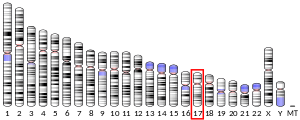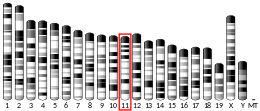DNAH9
Dynein heavy chain 9, axonemal is a protein that in humans is encoded by the DNAH9 gene.[5][6][7]
This gene encodes the heavy chain subunit of axonemal dynein, a large multi-subunit molecular motor. Axonemal dynein attaches to microtubules and hydrolyzes ATP to mediate the movement of cilia and flagella. The gene expresses at least two transcript variants; additional variants have been described, but their full length nature has not been determined.[7]
References
- GRCh38: Ensembl release 89: ENSG00000007174 - Ensembl, May 2017
- GRCm38: Ensembl release 89: ENSMUSG00000056752 - Ensembl, May 2017
- "Human PubMed Reference:". National Center for Biotechnology Information, U.S. National Library of Medicine.
- "Mouse PubMed Reference:". National Center for Biotechnology Information, U.S. National Library of Medicine.
- Vaughan KT, Mikami A, Paschal BM, Holzbaur EL, Hughes SM, Echeverri CJ, Moore KJ, Gilbert DJ, Copeland NG, Jenkins NA, Vallee RB (Feb 1997). "Multiple mouse chromosomal loci for dynein-based motility". Genomics. 36 (1): 29–38. doi:10.1006/geno.1996.0422. PMID 8812413.
- Bartoloni L, Blouin JL, Maiti AK, Sainsbury A, Rossier C, Gehrig C, She JX, Marron MP, Lander ES, Meeks M, Chung E, Armengot M, Jorissen M, Scott HS, Delozier-Blanchet CD, Gardiner RM, Antonarakis SE (Mar 2001). "Axonemal beta heavy chain dynein DNAH9: cDNA sequence, genomic structure, and investigation of its role in primary ciliary dyskinesia". Genomics. 72 (1): 21–33. doi:10.1006/geno.2000.6462. hdl:2123/16163. PMID 11247663.
- "Entrez Gene: DNAH9 dynein, axonemal, heavy chain 9".
Further reading
- Milisav I, Jones MH, Affara NA (1996). "Characterization of a novel human dynein-related gene that is specifically expressed in testis". Mamm. Genome. 7 (9): 667–72. doi:10.1007/s003359900202. PMID 8703119.
- Nagase T; Ishikawa K; Nakajima D; et al. (1997). "Prediction of the coding sequences of unidentified human genes. VII. The complete sequences of 100 new cDNA clones from brain which can code for large proteins in vitro". DNA Res. 4 (2): 141–50. doi:10.1093/dnares/4.2.141. PMID 9205841.
- Bartoloni L; Blouin J; Sainsbury AJ; et al. (1999). "Assignment of the human dynein heavy chain gene DNAH17L to human chromosome 17p12 by in situ hybridization and radiation hybrid mapping". Cytogenet. Cell Genet. 84 (3–4): 188–9. doi:10.1159/000015254. PMID 10393427.
- Reed W; Carson JL; Moats-Staats BM; et al. (2001). "Characterization of an axonemal dynein heavy chain expressed early in airway epithelial ciliogenesis". Am. J. Respir. Cell Mol. Biol. 23 (6): 734–41. CiteSeerX 10.1.1.321.874. doi:10.1165/ajrcmb.23.6.4045. PMID 11104725.
- Maiti AK; Mattéi MG; Jorissen M; et al. (2001). "Identification, tissue specific expression, and chromosomal localisation of several human dynein heavy chain genes". Eur. J. Hum. Genet. 8 (12): 923–32. doi:10.1038/sj.ejhg.5200555. PMID 11175280.
- Carson JL; Reed W; Lucier T; et al. (2002). "Axonemal dynein expression in human fetal tracheal epithelium". Am. J. Physiol. Lung Cell Mol. Physiol. 282 (3): L421–30. doi:10.1152/ajplung.00147.2001. PMID 11839535. S2CID 23922796.
- Strausberg RL; Feingold EA; Grouse LH; et al. (2003). "Generation and initial analysis of more than 15,000 full-length human and mouse cDNA sequences". Proc. Natl. Acad. Sci. U.S.A. 99 (26): 16899–903. doi:10.1073/pnas.242603899. PMC 139241. PMID 12477932.
- Ota T; Suzuki Y; Nishikawa T; et al. (2004). "Complete sequencing and characterization of 21,243 full-length human cDNAs". Nat. Genet. 36 (1): 40–5. doi:10.1038/ng1285. PMID 14702039.
- Horváth J; Fliegauf M; Olbrich H; et al. (2005). "Identification and analysis of axonemal dynein light chain 1 in primary ciliary dyskinesia patients". Am. J. Respir. Cell Mol. Biol. 33 (1): 41–7. doi:10.1165/rcmb.2004-0335OC. PMID 15845866.
This article is issued from Wikipedia. The text is licensed under Creative Commons - Attribution - Sharealike. Additional terms may apply for the media files.





